Palaeoenvironmental Conditions of the Upper Middle Pleistocene Warm Intervals in the Upper Volga Region, Northwestern Russia, Based on Palynological, Paleocarpological and Quantitative Geochronological Data
Abstract
1. Introduction
2. Materials and Methods
2.1. Location of the Sections
2.2. Study History of the Bolshaya Kosha (Ilya Prorok) Section
| Event | Climate |
|---|---|
| Moscow Glaciation (late stage) | Cold |
| Kostroma interstadial | Relatively warm |
| Moscow Glaciation (early stage) | Cold |
| Short-term climate fluctuations | Cooling |
| Warming | |
| Cooling | |
| Gorki Interglacial | Warm |
| Dnieper Glaciation | Cold |
| Short-term climate fluctuations | Cooling |
| Maryino warming | |
| Tegliatsi (Kaluga) cooling | |
| Bulatovo warming | |
| Cooling | |
| Kosha warming | |
| Cooling | |
| Likhvin Interglacial 1 | Warm |
2.3. Paleobotanical and Lithological Methods
2.4. Luminescence Dating
3. Results
3.1. Section Bolshaya Kosha (Ilya Prorok)
3.1.1. 3D geometry of Organogenic Sediments in the Bolshaya Kosha (Ilya Prorok) Section
3.1.2. Structure of the IP-2015 Section and Facial Interpretation of the Lithostratigraphic Units
3.1.3. Luminescence Dating
3.1.4. Carpological Analysis
3.2. Section Nazarovo
3.2.1. Geological Composition and Luminescence Age of Deposits
3.2.2. Results of Spore/Pollen Study
4. Discussion
4.1. Comparison of Middle Pleistocene Interstadial LCAs of the East European Plain
4.2. Interstadials of the Middle Pleistocene of the East European Plain According to Palynological Data
4.3. Geochronology of the Late Middle Pleistocene Warm Intervals in the East European Plain
4.4. Correlation with the Middle Pleistocene Warm Epochs in Other European Sections
5. Conclusions
Author Contributions
Funding
Data Availability Statement
Conflicts of Interest
References
- Zastrozhnov, A.; Danukalova, G.; Shick, S.; Kolfschoten, T. State of stratigraphic knowledge of Quaternary deposits in European Russia: Unresolved issues and challenges for further research. Quat. Int. 2018, 478, 4–26. [Google Scholar] [CrossRef]
- Lisiecki, L.E.; Raymo, M.A. Pliocene-Pleistocene stack of 57 globally distributed benthic D18O records. Paleoceanography 2005, 20, PA1003. [Google Scholar] [CrossRef]
- Cohen, K.M.; Gibbard, P.L. Global chronostratigraphical correlation table for the last 2.7 million years, version 2019 QI-500. Quat. Int. 2019, 500, 20–31. [Google Scholar] [CrossRef]
- Zhamoida, A.I.; Girshgorn, L.C.H.; Kovalevsky, O.P.; Oleynikov, A.N.; Prozorovskaya, E.L.; Margulis, L.S.; Khramov, A.N.; Shkatova, V.K. Stratigraphic Code of Russia (Stratigraphicheskyi kodeks Rossii), 3rd ed.; VSEGEI Press: Sankt Petersburg, Russia, 2006; p. 95. (In Russian) [Google Scholar]
- Velichko, A.A.; Morozova, T.D. Main features of soil formation during the Pleistocene on the East European Plain and their palaeogeographical interpretation. In Evolyutsiya Pochvi Pochvennogo Pokrova. Teoriya, Raznoobrazie Prirodnoi Evolyutsii i Antropogennykh Transformatsii Pochv; Kudeyarov, V.N., Ivanov, I.V., Eds.; GEOS: Moscow, Russia, 2015; pp. 321–323. (In Russian) [Google Scholar]
- Alekseev, A.S.; Shik, S.M. (Eds.) Resolution of regional interdepartmental stratigraphic commission (RISC) on the central and southern parts of the Russian platform Bureau on 16 March of 2010. Bull. Regional Mezhved. Stratigr. Comm. po Centru i Yugu Russ. Platf. 2012, 5, 10–18. (In Russian) [Google Scholar]
- Lindner, L.; Gozik, P.; Jełowiczewa, J.; Marciniak, B.; Marks, L. Głowne problem klimatostratygrafii czwartorzedu Polski, Białorusi i Ukrainy. In Geneza, Litologia i Stratygrafia Utworow Czwartorzedowych. Tom IV; Wydawnictwo Naukowe Uniwersytetu im. Adama Mickiewicza: Poznan, Poland, 2004; pp. 243–258. [Google Scholar]
- Marks, L.; Dzierżek, J.; Janiszewski, R.; Kaczorowski, J.; Lindner, L.; Majecka, A.; Makos, M.; Szymanek, M.; Tołoczko-Pasek, A.; Woronko, B. Quaternary stratigraphy and palaeogeography of Poland. Acta Geol. Pol. 2016, 66, 403–427. [Google Scholar] [CrossRef]
- Urban, B. Interglacial pollen records from Schöningen, north Germany. In The Climate of Past Interglacials; Sirocko, F., Claussen, M., Sànchez Goni, M.F., Litt, T., Eds.; Elsevier: Amsterdam, The Netherlands, 2007; pp. 417–444. [Google Scholar] [CrossRef]
- Ditmar, A.Y. Report on the geognostic study of Ostashkovsky, Rzhevsky, etc. counties. Mat. Dlya Geol. Ross. 1871, 3. (In Russian) [Google Scholar]
- Khimenkov, V.G. Geological studies in the north-western and northern parts of 43 sheets of the 10-verst map of Russia. Izv. Geol. Kom. 1913, 32. (In Russian) [Google Scholar]
- Maksimov, F.E.; Petrov, A.Y.; Grigoriev, V.A.; Konstantinov, E.A.; Kuznetsov, V.Y.; Arslanov, K.A.; Levchenko, S.B.; Karpukhina, N.V.; Starikova, A.A.; Baranova, N.G. 230Th/U age and paleobotanic description of the organic-rich layer from the “Ilya Prorok” section on the Bolshaya Kosha River (Upper Volga basin). Vestn. St. Petersburg Univ. Earth Sci. 2022, 67, 243–265. [Google Scholar] [CrossRef]
- Astakhov, V.; Shkatova, V.; Zastrozhnov, A.; Chuyko, M. Glaciomorphological Map of the Russian Federation. Quat. Int. 2016, 420, 4–14. [Google Scholar] [CrossRef]
- Stolyarova, T.I. Map of Quaternary Deposits. Sheet O-36-XXVIII, Scale 1:200,000 (Karta Chetvertichnyh Otlozhenij. List O-36-XXVIII, Masshtab 1:200,000); VSEGEI Press: Leningrad, Russia, 1961. (In Russian) [Google Scholar]
- Utkina, A.O.; Panin, A.V.; Kurbanov, R.N.; Murray, A.S. Unexpectedly old luminescence ages as an indicator of the origin of the upper Volga River valley sediments. Quat. Geochronol. 2022, 73, 101381. [Google Scholar] [CrossRef]
- Markov, K.K. Materials for the stratigraphy of Quaternary sediments of the Upper Volga basin. Tr. Verkhnevolzhskoi Eksped. 1940, 1, 4–38. (In Russian) [Google Scholar]
- Moskvitin, A.I. Geological sketch of the Kalinin region. Uch. zap. MGU 1939, 31, 29–108. (In Russian) [Google Scholar]
- Moskvitin, A.I. Odintsovo interglacial and the position of the Moscow glaciation among other glaciations in Europe. Bull. Mosc. Soc. Nat. Geol. Ser. 1946, 21, 79–98. (In Russian) [Google Scholar]
- Moskvitin, A.I. Wurmian Epoch (Neopleistocene) in the European Part of the USSR (Vyurmskaya Epoha (Neoplejstocen) v Evropejskoj Chasti SSSR); Izd-vo Akademii nauk SSSR: Moscow, Russia, 1950; pp. 53–56. (In Russian) [Google Scholar]
- Stolyarova, T.I.; Gotfri, B.A.; Simonova, G.F.; Sooper, K.N.; Kalandadze, I.N.; Shipilov, I.I. Report of the Selizhar Geological Survey Party (Ostashkovsky Detachment) on the Complex Geological Survey of the Mas-Headquarters 1:200,000 Sheet O-36-XXVIII, Produced in 1956–1957 (Otctet Selizharovskoi Geologo-Siomochnoi Partii (Ostashkovskii Otryad) o Kompleksnoi Geologicheskoi Siomke Masshtaba 1:200,000 Lista O-36-XXVIII, Proizvedionnoi v 1956–1957); GUCR: Moscow, Russia, 1958; p. 298. (In Russian) [Google Scholar]
- Chebotaryova, N.S.; Nedoshivina, M.A.; Stolyarova, T.I. The Moscow-Valdai (Mikulin) interglacial deposits in the Upper Volga basin and their significance for paleogeography. Byul. Kom. Po Izuch. Chetv. Per. 1961, 26, 35–49. (In Russian) [Google Scholar]
- Grichuk, V.P. Fossil floras as the basis for the Quaternary stratigraphy. In Relief and Stratigraphy of the Quaternary Deposits in the North-Western Part of the Russian Plain (Rel’yef i Stratigrafiya Chetvertichnykh Otlozheniy Severo-Zapadnoy Chasti Russkoy Ravniny); Markov, K.K., Ed.; Izdatel’stvo AN SSSR: Moscow, Russia, 1961; pp. 25–71. (In Russian) [Google Scholar]
- Grichuk, V.P. History of Flora and Vegetation of the Russian Plain in the Pleistocene (Istoriya Flory i Rastitel’nosti Russkoj Ravniny v Plejstocene); Nauka: Moscow, Russia, 1989; p. 184. (In Russian) [Google Scholar]
- Krasnov, I.I.; Kolesnikova, T.D. New data on interglacial deposits in the Upper Volga basin. Byul. Kom. Po Izuch. Chetv. Per. 1967, 31, 140–146. (In Russian) [Google Scholar]
- Velichkevich, F.Y. Pleistocene Flora of Glacial Regions of the East European Plain (Plejstocenovye Flory Lednikovyh Oblastej Vostochno-Evropejskoj Ravniny); Nauka i tekhnika: Minsk, Russia, 1982; p. 239. (In Russian) [Google Scholar]
- Pisareva, V.V.; Sudakova, N.G.; Zyuganova, I.S.; Karpukhina, N.V.; Zakharov, A.L. Debatable problems of the Middle Pleistocene stratigraphy of the East European Plain’s Central region. Byul. Kom. Po Izuch. Chetv. Per. 2019, 77, 49–85. (In Russian) [Google Scholar]
- Konstantinov, E.A.; Mukhametshina, E.O.; Karpukhina, N.V. Conditions of occurrence and properties of buried organogenic sediments of the Bolshaya Kosha River basin (Tver region). Est. i Tekhn. Nauk. 2017, 107, 56–61. (In Russian) [Google Scholar]
- Kozlov, V.B. Development of ancient lake basins on the territory of the Upper Volga. In History of the Pleistocene Lakes of the East European Plain (Istoriya Plejstocenovyh ozer Vostochno-Evropejskoj Ravniny); Nauka: Sankt-Petersburg, Russia, 1998; pp. 335–340. (In Russian) [Google Scholar]
- Pisareva, V.V. Reconstruction of paleolandscapes of the Likhvin interglacial and subsequent cooling in Eastern Europe. Izv. RAN. Ser. Geogr. 2012, 3, 54–70. (In Russian) [Google Scholar]
- Grichuk, V.P.; Zaklinskaya, Y.D. Analysis of Fossil Pollen and Spores and Its Application in Paleogeography (Analiz Iskopaemyh Pyl’cy i Spor i Ego Primenenie v Paleogeografii); OGIZ: Moscow, Russia, 1948; p. 223. (In Russian) [Google Scholar]
- Nikitin, V.P. Paleocarpological Method (Paleokarpologicheskij Metod); TGU: Tomsk, Russia, 1969; p. 82. (In Russian) [Google Scholar]
- Velichkevich, F.Y.; Zastawniak, E. Atlas of the Vascular Plant Macrofossils of Central and Eastern Europe, Part 1; W. Szafer Institute of Botany: Kraków, Poland, 2006; p. 224. [Google Scholar]
- Velichkevich, F.Y.; Zastawniak, E. Atlas of the Vascular Plant Macrofossils of Central and Eastern Europe, Part 2; W. Szafer Institute of Botany: Kraków, Poland, 2008; p. 380. [Google Scholar]
- Grimm, E.C. TGView, Version 2.0.2; Illinois State Museum, Research and Collections Center: Springfield, IL, USA, 2004. [Google Scholar]
- Dean, W.E. Determination of carbonate and organic matter in calcareous sediments and sedimentary rocks by loss on ignition; comparison with other methods. J. Sediment. Res. 1974, 44, 242–248. [Google Scholar]
- Murray, A.; Arnold, L.J.; Buylaert, J.-P.; Guérin, G.; Qin, J.; Singhvi, A.K.; Smedley, R.; Thomsen, K. Optically stimulated luminescence dating using quartz. Nat. Rev. Methods Primers 2021, 1, 72. [Google Scholar] [CrossRef]
- Hansen, V.; Murray, A.; Buylaert, J.-P.; Yeo, E.-Y.; Thomsen, K. A new irradiated quartz for beta source calibration. Rad. Meas. 2015, 81, 123–127. [Google Scholar] [CrossRef]
- Hansen, V.; Murray, A.; Thomsen, K.; Jain, M.; Autzen, M.; Buylaert, J.-P. Towards the origins of overdispersion in beta source calibration. Rad. Meas. 2018, 120, 157–162. [Google Scholar] [CrossRef]
- Thiel, C.; Buylaert, J.-P.; Murray, A.; Terhorst, B.; Hofer, I.; Tsukamoto, S.; Frechen, M. Luminescence dating of the Stratzing loess profile (Austria)—testing the potential of an elevated temperature post-IR IRSL protocol. Quat. Int. 2011, 234, 23–31. [Google Scholar] [CrossRef]
- Buylaert, J.P.; Jain, M.; Murray, A.S.; Thomsen, K.J.; Thiel, C.; Sohbati, R. A robust feldspar luminescence dating method for Middle and Late Pleistocene sediments. Boreas 2012, 41, 435–451. [Google Scholar] [CrossRef]
- Thomsen, K.J.; Murray, A.S.; Jai, M.; Bøtter-Jensen, L. Laboratory fading rates of various luminescence signals from feldspar-rich sediment extracts. Rad. Meas. 2008, 43, 1474–1486. [Google Scholar] [CrossRef]
- Murray, A.S.; Marten, R.; Johnston, A.; Martin, P. Analysis for naturally occurring radionuclides at environmental concentrations by gamma spectrometry. J. Radioanal. Nucl. Chem. 1987, 115, 263–288. [Google Scholar] [CrossRef]
- Murray, A.S.; Helsted, L.M.; Autzen, M.; Jain, M.; Buylaert, J.-P. Measurement of natural radioactivity: Calibration and performance of a high-resolution gamma spectrometry facility. Rad. Meas. 2018, 120, 215–220. [Google Scholar] [CrossRef]
- Guerin, G.; Mercier, N.; Nathan, R.; Adamiec, G.; Lefrais, Y. On the use of the infinite matrix assumption and associated concepts: A critical review. Rad. Meas. 2012, 47, 778–785. [Google Scholar] [CrossRef]
- Aitken, M.J. Thermoluminescence Dating; Academic Press: London, UK, 1985; p. 359. [Google Scholar]
- Prescott, J.R.; Hutton, J.T. Cosmic ray contributions to dose rates for luminescence and ESR dating: Large depths and long-term time variations. Rad. Meas. 1994, 23, 497–500. [Google Scholar] [CrossRef]
- Borisova, O.K.; Naryshkina, N.N.; Utkina, A.O.; Panin, A.V. On the diversity of interstadial environments of the Middle-Late Pleistocene in the Yaroslavl Volga region (according to palynological data). In Proceedings of the XV All-Russian Palynological Conference Pending Problems of Modern Palynology; Bolikhovskaya, N.S., Mamontov, D.A., Eds.; Lomonosov Moscow State University, GEOS: Moscow, Russia, 2022; pp. 91–96. (In Russian) [Google Scholar]
- Murray, A.S.; Thomsen, K.J.; Masuda, N.; Buylaert, J.-P.; Jain, M. Identifying well-bleached quartz using the different bleaching rates of quartz and feldspar luminescence signals. Rad. Meas. 2012, 47, 688–695. [Google Scholar] [CrossRef]
- Buylaert, J.-P.; Murray, A.S.; Gebhardt, A.C.; Sohbati, R.; Ohlendorf, C.; Thiel, C.; Wastegård, S.; Zolitschka, B. Luminescence dating of the PASADO core 5022-1D from Laguna Potrok Aike (Argentina) using IRSL signals from feldspar. Quat. Sci. Rev. 2013, 71, 70–80. [Google Scholar] [CrossRef]
- Yi, S.; Buylaert, J.-P.; Murray, A.S.; Lu, H.; Thiel, C.; Zeng, L. A detailed post-IR IRSL dating study of the Niuyangzigou loess site in northeastern China. Boreas 2016, 45, 644–657. [Google Scholar] [CrossRef]
- Kolesnikova, T.D.; Khomutova, V.I. Fossil Middle Pleistocene flora near the village of Bulatovo, Kalinin region. Bot. Zhurn. 1972, 57, 1422–1427. (In Russian) [Google Scholar]
- Yakubovskaya, T.V. Paleogeography of the Grodno Ponemanje’s Likhvin Interglacial (Paleogeografiya Lihvinskogo Mezhlednikov’ya Grodnenskogo Poneman’ya); Nauka i Tekhnika: Minsk, Russia, 1976; p. 298. (In Russian) [Google Scholar]
- Zyuganova, I.S. New data on the Middle Pleistocene flora of the Bulatovo section (Upper Volga basin). In Problems of Modern Palynology: Materials of the XIII Russian Palynological Conference with International Participation (Problemy sovremennoj palinologii. Materialy HIII Rossijskoj Palinologicheskoj Konferencii s Mezhdunarodnym Uchastiem); IG Komi NC Uro RAN: Syktyvkar, Russia, 2011; Volume 2, pp. 108–111. (In Russian) [Google Scholar]
- Field, M.; Velichkevich, F.; Andrieu-Ponel, V.; Woltz, P. Significance of Two New Pleistocene Plant Records from Western Europe. Quat. Res. 2000, 54, 253–263. [Google Scholar] [CrossRef]
- Zyuganova, I.S. Early Valdai carpological assemblages from the Upper Volga Region. Paleontol. J. 2010, 44, 1368–1378. (In Russian) [Google Scholar] [CrossRef]
- Elovicheva, Y.K. Continuous palynological record of paleogeographical events in the sediments of the paleolakes Kolodezhny (Belarus). In Women Scientists of Belarus and Kazakhstan: Proceedings of International Scientific-Practical Conference (Zhenshhiny-uchenye Belarusi i Kazahstana: Materialy Mezhdunarodnoj Nauchno-Prakticheskoj Konferentsii); Kazakova, I.V., Ed.; RIVSH: Minsk, Belarus, 2018; pp. 401–402. (In Russian) [Google Scholar]
- Zelikson, E.M. Climate and environment changes of East Europe during interstadials and interglacials of the Middle and Late Pleistocene. In Climate and Environment Changes of East Europe during Holocene and Late–Middle Pleistocene; Proceedings of the IGU Conference, Global Changes and Geography; Institute of Geography RAS: Moscow, Russia, 1995; pp. 80–92. [Google Scholar]
- Grichuk, V.P.; Gurtovaya, Y.Y. Interglacial lake-marsh deposits near the village of Krukenichi. In Questions of Paleogeography of the Pleistocene Glacial and Periglacial Regions (Voprosy Paleogeografii Plejstocena Lednikovyh i Periglyacial’nyh Oblastej); Nauka: Moscow, Russia, 1981; pp. 59–91. (In Russian) [Google Scholar]
- Ushko, K.A. Likhvinsky (Chekalinsky) section of interglacial lake sediments. In Ice Age on the Territory of the European Part of the USSR and Siberia (Lednikovyj period na Territorii Evropejskoj Chasti SSSR i Sibiri); Izd-vo MGU: Moscow, Russia, 1959; pp. 148–226. (In Russian) [Google Scholar]
- Lindner, L.; Bogucki, A.; Gozhik, P.; Marciniak, B.; Marks, L.; Lanczont, M.; Wojtanowicz, J. Correlation of main climatic glacial-interglacial and loess-palaeosol cycles in the Pleistocene of Poland and Ukraine. Acta Geol. Pol. 2002, 52, 459–469. [Google Scholar]
- Nitychoruk, J.; Bińka, K.; Hoefs, J.; Ruppert, H.; Schneider, J. Climate reconstruction for the Holsteinian Interglacial in eastern Poland and its comparison with isotopic data from Marine Isotope Stage 11. Quat. Sci. Rev. 2005, 24, 631–644. [Google Scholar] [CrossRef]
- Nitychoruk, J.; Bińka, K.; Ruppert, H.; Schneider, J. Holsteinian Interglacial = Marine Isotope Stage 11? Quat. Sci. Rev. 2006, 25, 2678–2681. [Google Scholar] [CrossRef]
- Shik, S.M. Interglacial deposits of the center of European Russia (on the history of discovery and study). Byul. Kom. Po Izuch. Chetv. Per. 2005, 66, 98–106. (In Russian) [Google Scholar]
- Coope, G.R.; Kenward, H.K. Evidence from coleopteran assemblages for a short but intense cold interlude during the latter part of the MIS11 Interglacial from Quinton, West Midlands, UK. Quat. Sci. Rev. 2007, 26, 3276–3285. [Google Scholar] [CrossRef]
- Shik, S.M. A modern approach to the Neopleistocene stratigraphy and paleogeography of Central European Russia. Stratigr. Geol. Correl. 2014, 22, 219–230. [Google Scholar] [CrossRef]
- Bolikhovskaya, N.S.; Molod’kov, A.N. Climate chronostratigraphic scheme of the Pleistocene of the East European Plain: Periodization, correlation and age of climatic events. In Neogene and Flats of Russia: Stratigraphy, Events and Paleogeography (Neogen i Kvarter Rossii: Stratigrafiya, Sobytiya i Paleogeografiya); GEOS: Moscow, Russia, 2018; pp. 99–110. (In Russian) [Google Scholar]
- Geyh, M.A.; Müller, H. Numerical 230Th/U dating and a palynological review of the Holsteinian/Hoxnian Interglacial. Quat. Sci. Rev. 2005, 24, 1861–1872. [Google Scholar] [CrossRef]
- Velichko, A.A.; Pisareva, V.V.; Faustova, M.A. Glaciations and interglacials of East European Plain in the Early and Middle Pleistocene. Stratigr. Geol. Correl. 2005, 13, 195–211. [Google Scholar]
- Kühl, N.; Litt, T. Quantitative time series reconstructions of Holsteinian and Eemian temperatures using botanical data. In The Climate of Past Interglacials; Sirocko, F., Claussen, M., Sanchez Goñi, M.F., Litt, T., Eds.; Elsevier: Amsterdam, The Netherlands, 2007; pp. 239–254. [Google Scholar] [CrossRef]
- Shik, S.M. On the paleobotanical characterization of the Post-Tikhvin interglacials of the Middle Pleistocene of the East European Plain. Byul. Kom. Po Izuch. Chetv. Per. 2014, 73, 77–86. (In Russian) [Google Scholar]
- Koutsodendris, A.; Müller, U.C.; Pross, J.; Brauer, A.; Kotthoff, U.; Lotter, A.F. Vegetation dynamics and climate variability during the Holsteinian interglacial based on a pollen record from Dethlingen (northern Germany). Quat. Sci. Rev. 2010, 29, 3298–3307. [Google Scholar] [CrossRef]
- Urban, B.; Sierralta, M.; Frechen, M. New evidence for vegetation development and timing of Upper Middle Pleistocene interglacials in Northern Germany and tentative correlations. Quat. Int. 2011, 241, 125–142. [Google Scholar] [CrossRef]
- Urban, B.; Kasper, T.; Krahn, K.J.; Van Kolfschoten, T.; Rech, B.; Holzheu, M.; Tucci, M.; Schwalb, A. Landscape dynamics and chronological refinement of the Middle Pleistocene Reinsdorf Sequence of Schöningen, NW Germany. Quat. Res. 2023, 114, 148–177. [Google Scholar] [CrossRef]
- Jechorek, H. Die fossile Flora des Reinsdorf-Interglazials. Paläokarpologische Untersuchungen an mittelpleistozänen Ablagerungen im Braunkohlentagebau Schöningen. Praehistoria Thuring. 2000, 4, 7–17. [Google Scholar]
- Hrynowiecka, A.; Winter, H. Palaeoclimatic changes in the Holsteinian Interglacial (Middle Pleistocene) on the basis of indicator-species method—Palynological and macrofossils remains from Nowiny Żukowskie site (SE Poland). Quat. Int. 2016, 409 Pt B, 255–269. [Google Scholar] [CrossRef]
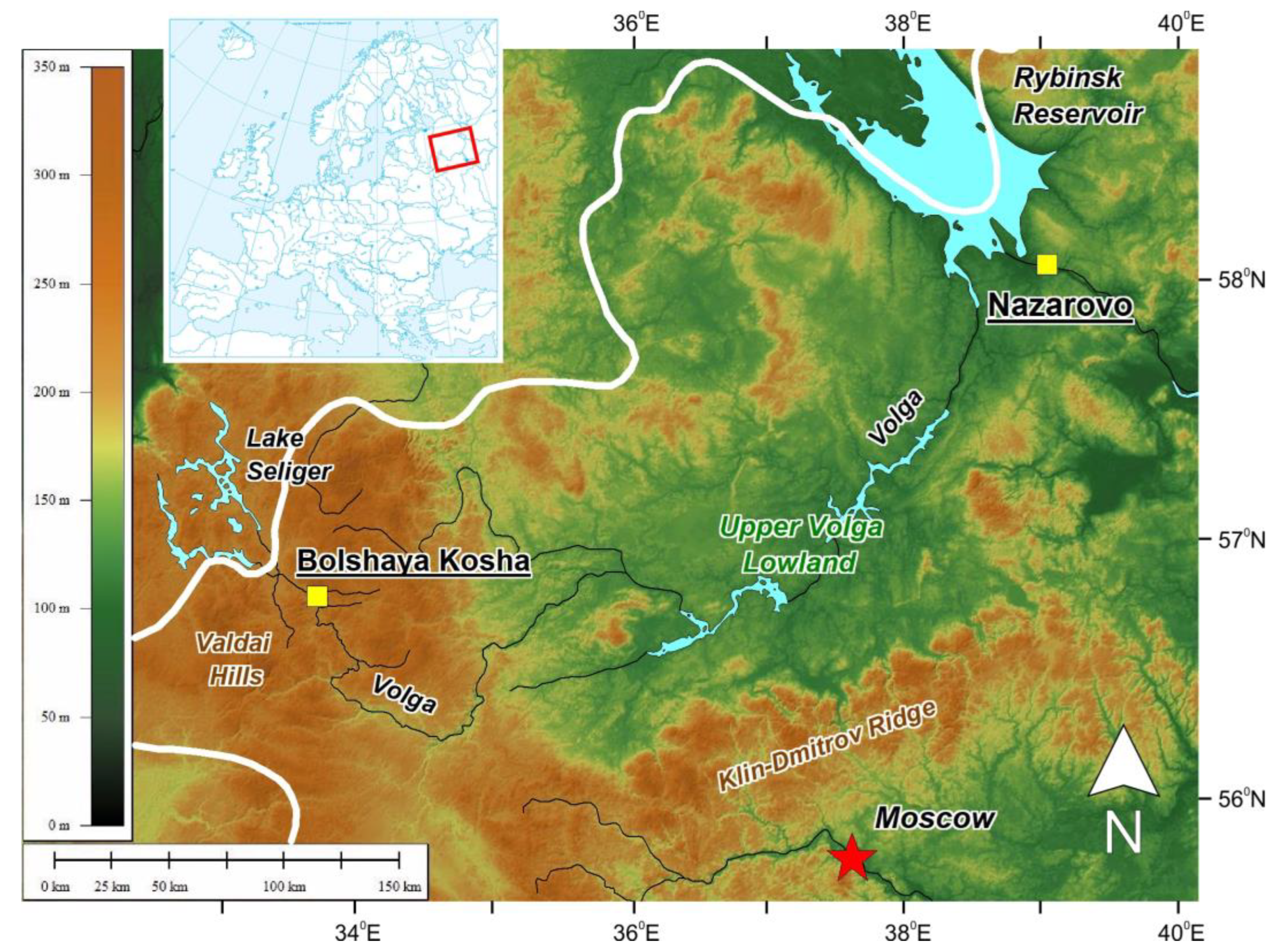
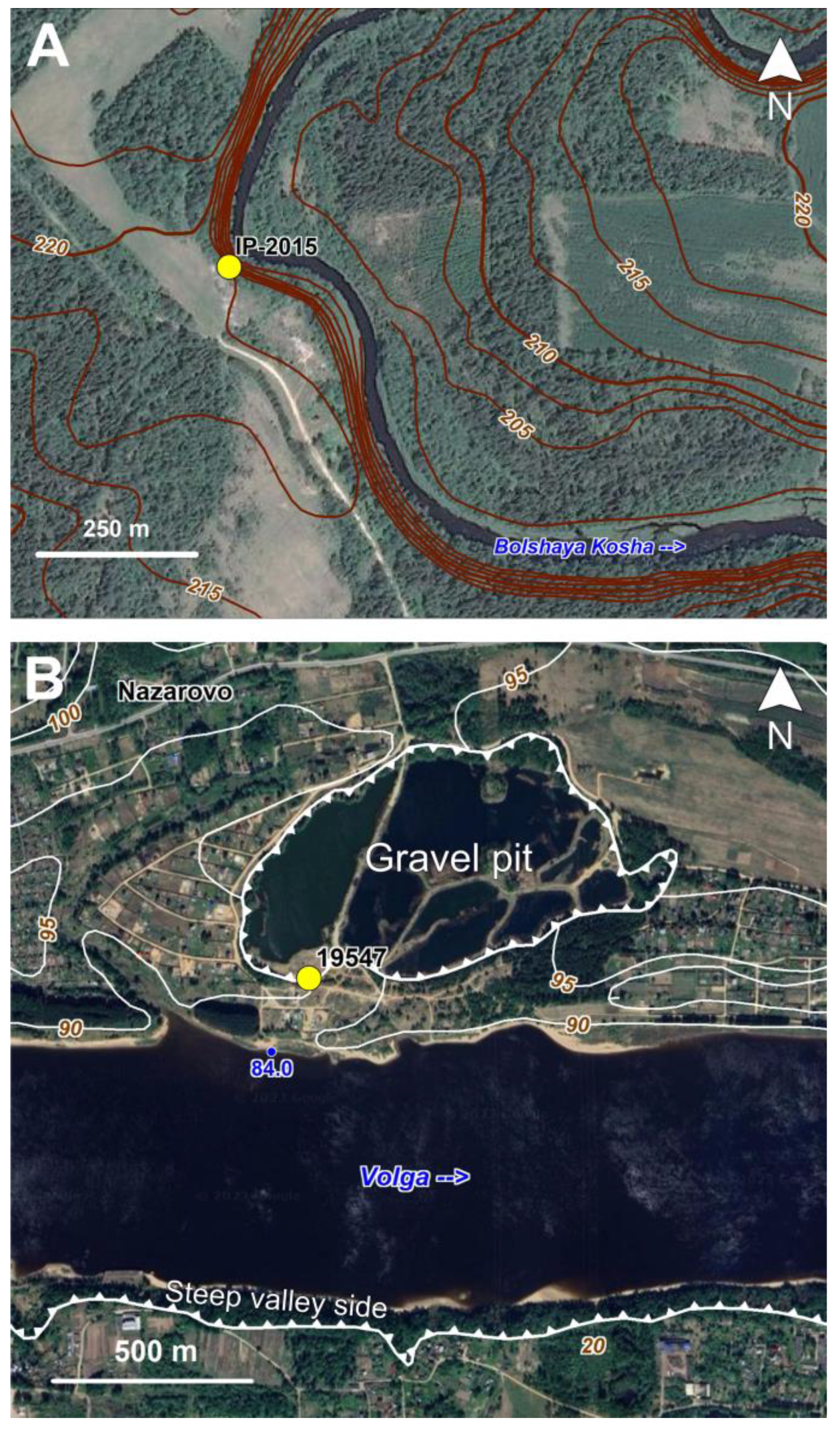




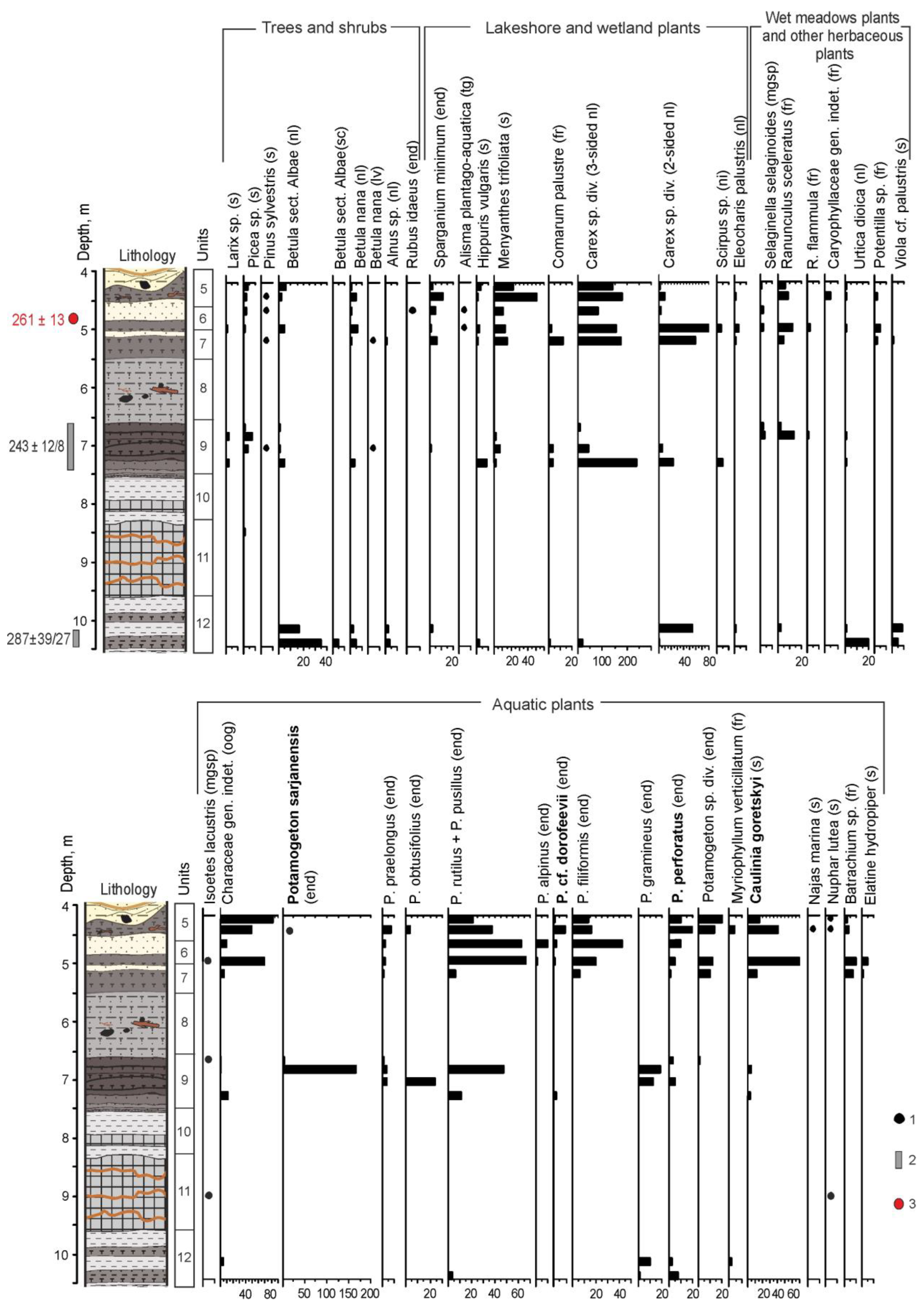

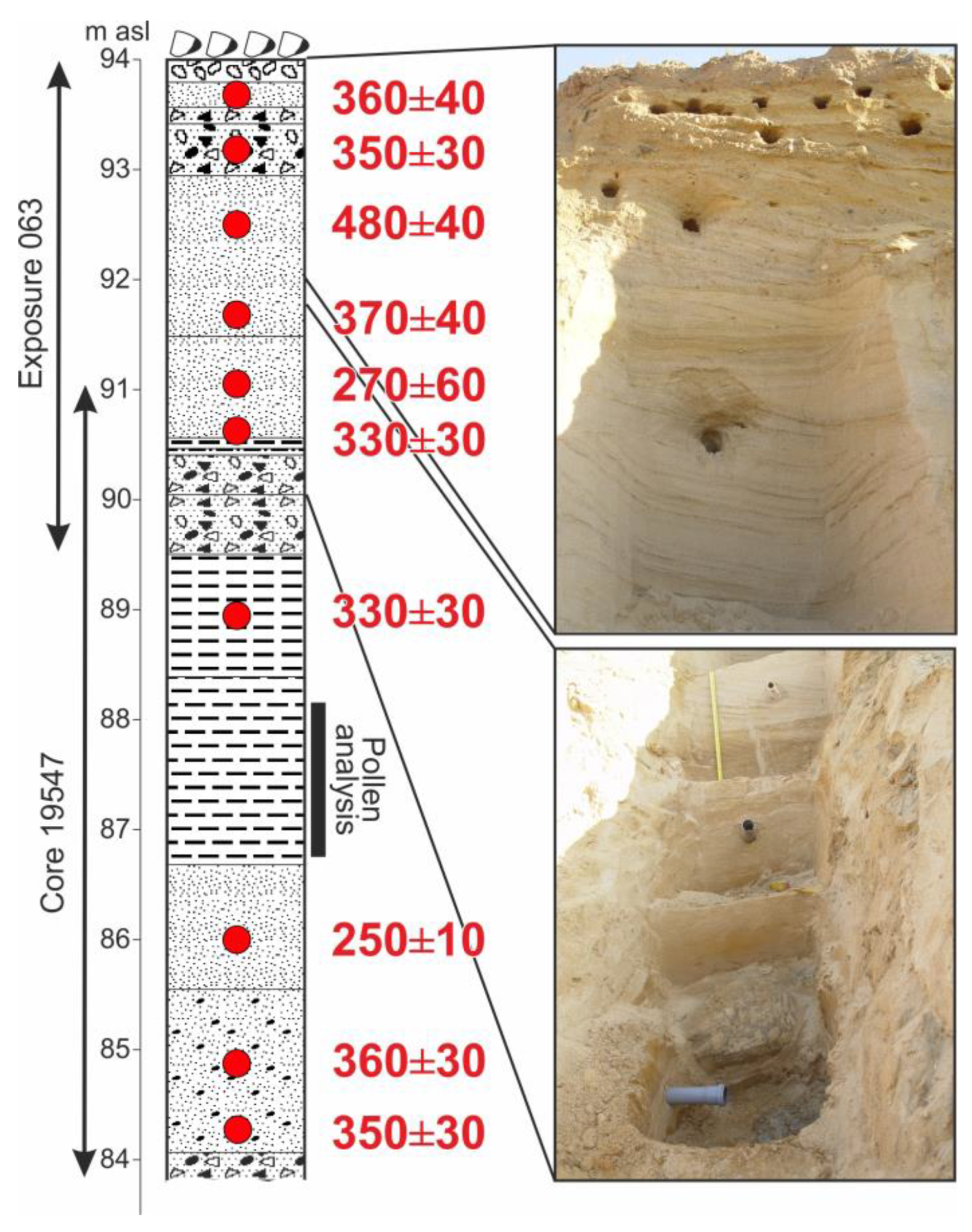
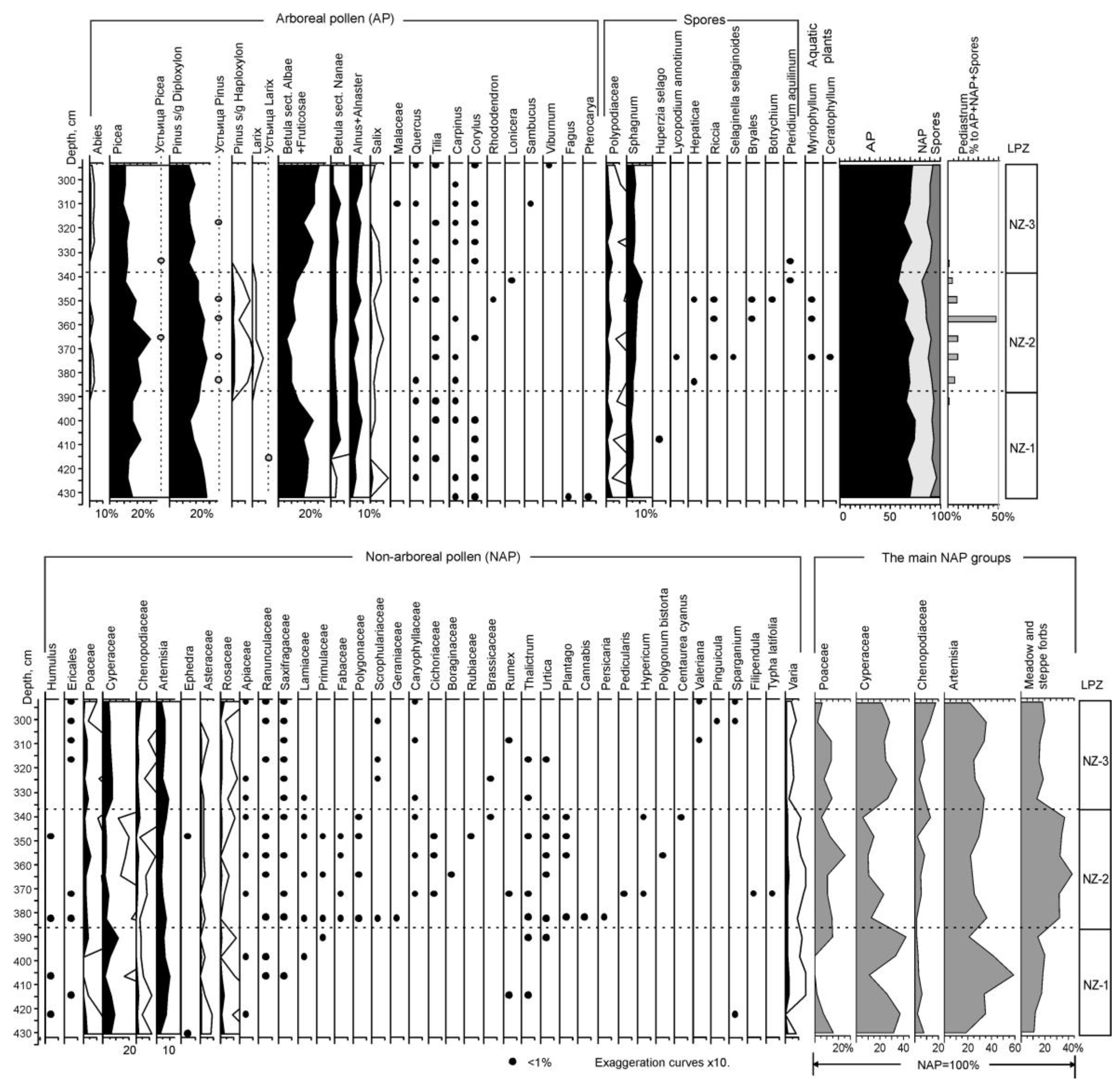
| MIS 1 | ISC 2 | GSCR3 | Eastern Europe | Central Europe | ||||
|---|---|---|---|---|---|---|---|---|
| European Russia 4 | European Russia 5 | Belarus 6 | Poland 7 | Germany 8 | ||||
| 6 | Middle Pleistocene | Middle Neo-pleistocene | Dnieper | Moscow | Dnieperian II (Prypec) | Odranian | Saalian complex | Drenthe + Warthe |
| 7 | Kamenka | Gorki | Shklovian | Lublinian | Schoningen | |||
| 8 | Pechora | Vologda | Cooling | Krznanian | ? (Cooling) | |||
| 9 | Likhvin | Chekalin | Smolenskian | Zbójnian | Reinsdorf | |||
| 10 | Oka | Kaluga | Cooling | Liwiecian | Fuhne | |||
| 11 | Likhvin | Alexandrian | Mazovian | Holsteinian | ||||
| 12 | Lower Neo-pleistocene | Oka | Berezinian | Sanian-2 | Elsterian | |||
| Unit No. ¹ | Description |
|---|---|
| 1 | Red loamy sand with gravel, pebbles, and small boulders (upper 30 cm without inclusions) |
| 2 | Coarse cross-bedded sand with gravel and pebbles |
| 3 | Pebble in sand and gravel matrix and inclusions of small boulders |
| 4 | Coarse laminated sand with inclusions of pebbles and gravel |
| 5 | Dark brown light peaty silt loam with inclusions of undecayed wood fragments |
| 6 | Grey fine sand with thin interlayers of peat |
| 7 | Dark brown (up to black) peat of high degree of decomposition, with thin interlayers of silt and fine sand and rare inclusions of wood fragments |
| 8 | Dark grey light peaty silt loam with rare inclusions of gravel, pebbles and small boulders, as well as with inclusions of poorly decomposed wood fragments (branches, small trunks) |
| 9 | Brownish-black peat of low decomposition, dense, leafy, with abundance of wood remains |
| 10 | Grey clay loam with argillite interlayers |
| 11 | Brownish-brown argillite with ferruginous films and crusts on the surfaces of laminae |
| 12 | Dark grey silty clay loam with blue tinge, with large spots of dark brown colour, with inclusion of grus (angular coarse sand and fine gravel) and fine sand, with interlayer of peaty black loam (2 cm) |
| 13 | Bluish-grey unlayered clay |
| 14 | Grey-brown clay loam with bluish and rusty spots, with inclusion of grus and angular gravel |
| 15 | Coarse-grained clayey brownish-reddish-pale oblique sand with inclusions of crushed stone |
| 16 | Pebble in sandy-gravel matrix and inclusion of boulders |
| 17 | Fine–medium cross-bedded sand |
| 18 | Pebble in sandy-gravel matrix and inclusion of small boulders |
| Sample Code Lab | Depth, cm | Dose (Gy) and Total Aliquots | Quartz Dose Rate, Gy/ka * | Age, ka | |||||||
|---|---|---|---|---|---|---|---|---|---|---|---|
| Q | IR50 | pIRIR290 | Q | IR50 | pIRIR290 | ||||||
| 208446 | 300 | >220 | 6 | 390 ± 11 | 8 | 629 ± 32 | 8 | 1.56 ± 0.07 | >141 | 156 ± 7 | 251 ± 17 |
| 208447 | 480 | >220 | 6 | 388 ± 17 | 8 | 647 ± 19 | 8 | 1.60 ± 0.07 | >137 | 153 ± 9 | 254 ± 13 |
| 208448 | 1400 | >220 | 6 | >400 | 6 | >1000 | 6 | 1.20 ± 0.06 | >183 | >186 | >466 |
Disclaimer/Publisher’s Note: The statements, opinions and data contained in all publications are solely those of the individual author(s) and contributor(s) and not of MDPI and/or the editor(s). MDPI and/or the editor(s) disclaim responsibility for any injury to people or property resulting from any ideas, methods, instructions or products referred to in the content. |
© 2024 by the authors. Licensee MDPI, Basel, Switzerland. This article is an open access article distributed under the terms and conditions of the Creative Commons Attribution (CC BY) license (https://creativecommons.org/licenses/by/4.0/).
Share and Cite
Panin, A.; Konstantinov, E.; Borisova, O.; Zyuganova, I.; Baranov, D.; Karpukhina, N.; Utkina, A.; Naryshkina, N.; Kurbanov, R. Palaeoenvironmental Conditions of the Upper Middle Pleistocene Warm Intervals in the Upper Volga Region, Northwestern Russia, Based on Palynological, Paleocarpological and Quantitative Geochronological Data. Quaternary 2024, 7, 24. https://doi.org/10.3390/quat7020024
Panin A, Konstantinov E, Borisova O, Zyuganova I, Baranov D, Karpukhina N, Utkina A, Naryshkina N, Kurbanov R. Palaeoenvironmental Conditions of the Upper Middle Pleistocene Warm Intervals in the Upper Volga Region, Northwestern Russia, Based on Palynological, Paleocarpological and Quantitative Geochronological Data. Quaternary. 2024; 7(2):24. https://doi.org/10.3390/quat7020024
Chicago/Turabian StylePanin, Andrei, Evgeny Konstantinov, Olga Borisova, Inna Zyuganova, Dmitrii Baranov, Natalia Karpukhina, Anna Utkina, Natalia Naryshkina, and Redzhep Kurbanov. 2024. "Palaeoenvironmental Conditions of the Upper Middle Pleistocene Warm Intervals in the Upper Volga Region, Northwestern Russia, Based on Palynological, Paleocarpological and Quantitative Geochronological Data" Quaternary 7, no. 2: 24. https://doi.org/10.3390/quat7020024
APA StylePanin, A., Konstantinov, E., Borisova, O., Zyuganova, I., Baranov, D., Karpukhina, N., Utkina, A., Naryshkina, N., & Kurbanov, R. (2024). Palaeoenvironmental Conditions of the Upper Middle Pleistocene Warm Intervals in the Upper Volga Region, Northwestern Russia, Based on Palynological, Paleocarpological and Quantitative Geochronological Data. Quaternary, 7(2), 24. https://doi.org/10.3390/quat7020024









